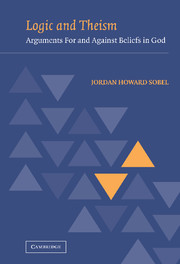Book contents
- Frontmatter
- Contents
- Preface
- DIVINITY
- ARGUMENTS FOR THE EXISTENCE OF GOD
- II Classical Ontological Arguments
- III Modern Modal Ontological Arguments
- IV Kurt Gödel's Ontologischer Beweis
- V First Causes “The Second Way”
- VI Ultimate Reasons: Proofs a contingentia mundi
- VII Look ’Round! – Arguments from Design
- VIII Clouds of Witnesses – “Of Miracles”
- ON TWO PARTS OF THE COMMON CONCEPTION
- ARGUMENTS AGAINST THE EXISTENCE OF GOD
- PRACTICAL ARGUMENTS FOR AND AGAINST THEISTIC BELIEFS
- Notes
- References
- Index of Names
IV - Kurt Gödel's Ontologischer Beweis
Published online by Cambridge University Press: 28 July 2009
- Frontmatter
- Contents
- Preface
- DIVINITY
- ARGUMENTS FOR THE EXISTENCE OF GOD
- II Classical Ontological Arguments
- III Modern Modal Ontological Arguments
- IV Kurt Gödel's Ontologischer Beweis
- V First Causes “The Second Way”
- VI Ultimate Reasons: Proofs a contingentia mundi
- VII Look ’Round! – Arguments from Design
- VIII Clouds of Witnesses – “Of Miracles”
- ON TWO PARTS OF THE COMMON CONCEPTION
- ARGUMENTS AGAINST THE EXISTENCE OF GOD
- PRACTICAL ARGUMENTS FOR AND AGAINST THEISTIC BELIEFS
- Notes
- References
- Index of Names
Summary
INTRODUCTION
Texts and style. Photocopies of three handwritten pages titled “Güdel's Ontological Proof” (Appendix B) began to circulate in the early 1980s. The handwriting is Dana Scott's; the ideas are Kurt Güdel's. They agree with ideas conveyed in two pages of notes in Güdel's own hand dated 10 February (Appendix A). Scott's three pages, on which I concentrate here, contain a sketch of a theory of positive properties, individual essences, and necessary existence that culminates in a theorem that says that it is necessary that there is a being that has every positive property. The plan of the proof honors Leibniz. It goes through demonstrations of the possibility of such a being, and that such a being is either not possible or necessary. Its style is Spinozistic but formal: Axioms and definitions are set, and theorems are proved in a formal language that is free of amphibolies that bother classical proofs. Its logic is quantified modal, not simply quantificational as classical proofs, nor only sentential modal as Hartshorne's. As said, it does not merely postulate the possibility of its God-like being but demonstrates it with no suggestion that it is forthcoming given merely the conceivability of a being that has every positive property, and that this definition of God-likeness harbors no contradiction.
- Type
- Chapter
- Information
- Logic and TheismArguments for and against Beliefs in God, pp. 115 - 167Publisher: Cambridge University PressPrint publication year: 2003



